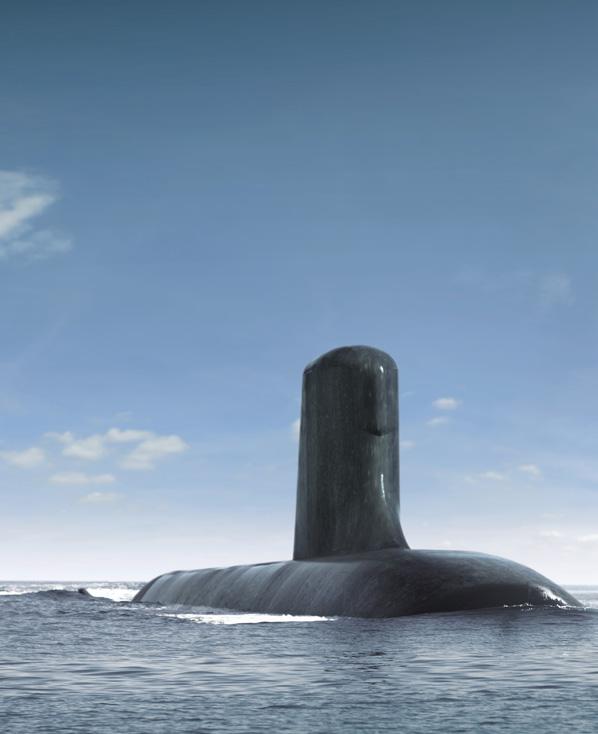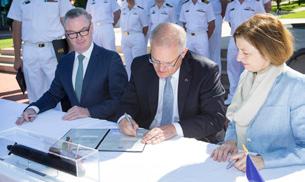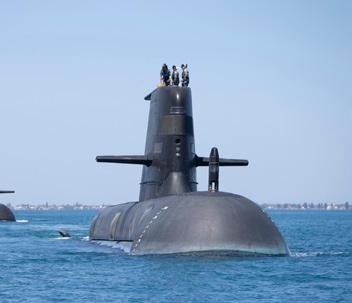
10 minute read
SUBS REPORT ANAO SEA1000 report
from ADBR JAN-FEB 2020
by adbr5
SUBS REPORTS ANAO REPORT
ANAO releases report into the SEA 1000 future submarine program
Advertisement
BY MAX BLENKIN

The Australian National Audit Office (ANAO) has detailed just how fraught negotiations were with Naval Group on the contract for construction of the 12 new Attack class submarines, with the Commonwealth revealing that one option was to walk away and start again.
The ANAO report, released on January 14 noted lead negotiator RADM Greg Sammut, head of the new submarines project, said negotiation of the Strategic Partnering Agreement (SPA) had been challenging and had taken longer than anticipated.
In its latest examination of the Future Submarine program, the ANAO – described by some defence analysts as glass half empty type of people when it comes to examining complex defence projects – actually gave defence a big tick.
‘Defence, through the Strategic Partnering Agreement, has established a fit-for-purpose strategic partnership framework that addresses the Government’s objectives for the Future Submarine Program,’ it said. ‘The Agreement includes provisions which address 11 of the 12 documented contract goals and provide a basis for establishing a successful strategic partnership and delivering shared program objectives. Defence has assured the Government that the remaining contract goal has been addressed.’
The ANAO made no recommendations, though it did identify some key messages relating to procurement, including instances of good practice identified in this audit.
That relates to establishing and maintaining expert oversight, identifying risks and mitigation strategies and active management of complex acquisition projects.
Now for the bad news. The project is already running nine months late. That’s against Defence’s pre-design contract estimates, with two major contracted milestones pushed out. ‘As a result, Defence cannot demonstrate that its expenditure of $396 million on design of the Future Submarine has been fully effective in achieving the program’s two major design milestones to date,’ ANAO said. ‘Defence expenditure on design represents some 47 per cent of all program expenditure to September 30, 2019.’
These milestones are the Systems Requirements Review (Definition Phase, Platform Systems) intended for March 2019 but achieved in October 2019, and the Preliminary Design Review (Platform Systems) planned for March 2020 and now set for January 2021.
Defence is optimistic it can recover some of that delay.
It said lessons from the initial concept studies
review highlighted the need to allow additional time for Naval Group to meet Defence’s requirements for a high level of design maturity before progressing to subsequent phases.
‘As challenging as construction will be (where 90 per cent of the funding will be spent), success will be driven by preparations during the design of the Future Submarine, when much of the engineering effort will be required, supported by enabling disciplines including program management and procurement,’ Defence said in its ANAO report response.
Negotiation of the SPA – the over-arching agreement between the Commonwealth and Naval Group – began in November 2017 and concluded in November 2018. In that time there were 12 negotiation sessions running for more than 100 days. Various reports indicated there were problems, citing the difficulties in reaching agreement on key provisions. This was attributed to differences in corporate culture – on the Australian side a procurement process more attuned to doing business with the Americans but with Naval Group being a majority French government-owned entity used to doing business the European way. ‘Defence is optimistic it can recover some of that delay.’
THRESHOLDS The ANAO report adds a little bit to what is known of the year-long process and how it proceeded. A Negotiation Reference Committee comprising senior Defence officials and three external advisors was established in November 2017 to provide advice and guidance to the negotiating team. Additional oversight came from the Naval Shipbuilding Advisory Board (NSAB), established in December 2016 to provide expert third party advice to government on all aspects of naval shipbuilding.
Ahead of the start of negotiations, Defence established a long list of threshold issues. These included acquiring a regionally superior submarine fit for purpose, intellectual property (IP) and data rights, allocation of responsibilities between the Commonwealth, Naval Group and combat system supplier Lockheed Martin Australia, consequences of termination, break payments, contract architecture, and levels of Australian industry capability (AIC).
In December 2017, Defence approved a contract negotiation directive to instruct the negotiating team on roles and responsibilities, negotiation objectives and principles, the Commonwealth’s preferred and fallback positions on threshold negotiation issues, and the anticipated schedule. RADM Sammut provided regular progress updates, and the ANAO cited from his December 2018 report, just after negotiations concluded: “The Future Submarine Program will be the most challenging acquisition program to be undertaken by Defence,” RADM Sammut said.
“It will be a mega-project by all international standards. As challenging as construction will be… success will be driven by preparations during the design of the future submarine, when much of the engineering effort will be required, supported by enabling disciplines including program management and procurement.
“Negotiation of the Strategic Partnering Agreement with Naval Group has been challenging and has taken longer than anticipated,” he conceded. The option of abandoning the deal emerged in a September 2018 NSAB submission to government which recommended Defence examine alternatives should negotiations not succeed. It also suggested Defence should assess whether program risks outweighed the benefits of proceeding, even if SPA negotiations succeeded.
Defence told the ANAO in response to the NASB recommendation that it had examined what additional service life of the current Collins class boats would be delivered under life-of-type extension, and – if necessary – the time this would allow development of a new acquisition strategy for the Attack class.
On three occasions during negotiations, Defence escalated issues for consideration of the Defence Minister and/or Prime Minister. That related to Defence’s approach to negotiations, liability caps

and, crucially, the right to terminate any contracts with Naval Group in event of a change of ownership. That appears to have been a key sticking point. The French position was that Australia did not have the right to terminate in those circumstances if agreement could not be reached, and Australia eventually accepted this position.
During the design and mobilisation phase, Defence identified differing systems engineering and industrial engineering methodologies between France and Australia which it designated as of extreme risk.
Lessons learned from the Collins submarine program indicated that production drawings provided for construction of an item in Australia did not always convey the “tribal knowledge” acquired by the original builder. That was to have been addressed by Naval Group in a Transfer of Technology Forward Options Report which has been delayed.
To mitigate some of this type of risk and to allow time for development of Australian industry capability, Defence is proposing that some complex elements of the hull of submarine number one will be constructed in France.
(L-R) Then Minister for Defence Christopher Pyne, Prime Minister Scott Morrison, and French Minister for the Armed Forces, Madame Florence Parly, sign the Strategic Partnering Agreement (SPA) in February 2019. DEFENCE
KEEN INTEREST Considering the magnitude of the project, its enormous cost, and the numerous defence projects which have run into trouble in the recent past, it’s unsurprising the ANAO is taking a keen interest in the future submarine program.
Project SEA 1000’s cost is staggering, and dwarfs anything before. Last November, Defence advised the Senate that the acquisition cost of the future submarine was ‘in the order of $80 billion outturned’ with an estimated sustainment cost of $145 billion out-turned to 2080. Out-turned means the cost is adjusted up for future inflation.
This is ANAO’s third performance audit examining the future submarine program, and many more can be expected through to the end. In this latest report, the ANAO provided a useful timeline on the process to date.
The RAN is at risk of a capability gap if the Collins class cannot remain capability relevant until sufficient Attack class boats are in service.. DEFENCE
In April 2016, then Prime Minister Malcolm Turnbull announced the winner was DCNS, now Naval Group. To get the show on the road while the SPA was negotiated, Defence and Naval Group signed the Design and Mobilisation Contract in September 2016. That optimistically foreshadowed the SPA would be in place by October 2017.
The first contract entered under the SPA was the Submarine Design Contract signed on March 1 2019. The SPA and Submarine Design Contract supersede the Future Submarine Program Design and Mobilisation Contract. But the ANAO says the Program Design and Mobilisation Contract will remain open until specific items are delivered.
Meanwhile, Defence, Naval Group, and Lockheed Martin Australia – the chosen combat systems integrator – signed a tripartite co-operative arrangement in May 2017.
The ANAO report also provided a breakdown of where the money had gone. It said total spending from June 2016 through to September 2018 amounted to $834 million, of which Naval Group (France) received $446 million, Naval Group Australia $10 million, Lockheed Martin Australia $148 million, and ASC $47 million. The balance totalling around $150 million has gone to various other contractors and in defence costs, including travel and overseas postings.
Defence noted that it needed people with particular skills who were in short supply in both Defence and the Australian public service. It said it has been forced to compete on the international market, including against its own submarine partners, to acquire people with the right skills.

TRANSITION In the meantime, with the first of the new Attack class submarines not set to enter service until the mid2030s, Navy will have to sustain the six Collins class boats. A delay of more than three years in delivery of the new subs will result in a capability gap, with a reduced number of the older Collins boats available. Defence is still working on its key mitigation strategy, the Collins life-of-type extension program, Project SEA 1450, which has yet to proceed through first gate approval. However, it’s planned that life extension will begin with the first Collins full cycle docking in 2026.
To assist the transition from Collins class to the Attack class, Defence is considering installing subsystems and components in upgraded Collins boats that will be common to the Attack class. Defence says this will allow it to test these sub-systems and enable training of submariners before transitioning to the Attack class.
POST-REPORT RESPONSE Following the release of the report and subsequent media commentary, Defence issued an unprecedented joint statement attributed to Department Secretary Greg Moriarty, Chief of Defence GEN Angus Campbell, Chief of Navy VADM Mike Noonan, and Deputy Secretary National Naval Shipbuilding RADM Tony Dalton.
“Australia is fully committed to working with France and Naval Group to deliver the Attack Class Submarine fleet, which remains a strategically vital capability for our Defence Force into the future,’ the statement reads.
“Contrary to media interpretations of ANAO’s latest report on the future submarine program, Defence was not advised to ‘walk away’ from Naval Group by the Naval Shipbuilding Advisory Board,’”it added. “In line with best practice and following the advice of the Advisory Board, Defence has continued to assess all of the risks that attend this highly complex program. At each stage, we are adopting relevant risk mitigation strategies. The ANAO acknowledges that Defence has taken steps to manage risks.
“The ANAO also concluded that Defence established a fit-for-purpose strategic partnership framework with Naval Group. Having done so, Defence continues to actively manage its contractual arrangements with Naval Group as both parties work closely to meet the inevitable challenges that will arise with a program of this scale and complexity.
“Defence has continued to ensure that design of the Attack class has progressed to the required high levels of design maturity, providing greater certainty that our capability requirements will be met, and avoiding costly and lengthy delays that would otherwise eventuate during the construction phase of the program.”










